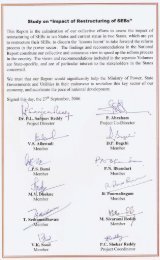CDM based CFL scheme - Ministry of Power
CDM based CFL scheme - Ministry of Power
CDM based CFL scheme - Ministry of Power
You also want an ePaper? Increase the reach of your titles
YUMPU automatically turns print PDFs into web optimized ePapers that Google loves.
Lighting accounts for almost 20% <strong>of</strong> the total electricity<br />
demand in the country, and is a major component <strong>of</strong><br />
the peak load. The majority <strong>of</strong> lighting needs in the<br />
country are met by incandescent bulbs, particularly in<br />
the household sector, which are extremely energy<br />
inefficient as over 90% <strong>of</strong> the electricity is converted<br />
into heat, and only upto 10% is used for lighting. <strong>CFL</strong>s<br />
provide an energy-efficient alternative to the<br />
incandescent lamp by using one-fifth as much electricity<br />
as an incandescent lamp to provide the same level <strong>of</strong><br />
illumination. <strong>CFL</strong>s have almost completely penetrated<br />
the commercial market, and the sales <strong>of</strong> <strong>CFL</strong>s in India<br />
have grown from about 20 million in 2003 to around<br />
200 million in 2008. Statistics by lighting association<br />
indicates that the penetration <strong>of</strong> Compact Fluorescent<br />
Lamps (<strong>CFL</strong>s) in household sector is only about 5% -<br />
10%; the relatively low penetration rate is largely due<br />
to the high price <strong>of</strong> the <strong>CFL</strong>s, which costs 8-10 times as<br />
much as incandescent bulbs. It is estimated that about<br />
400 million light points in India today are lighted by<br />
incandescent bulbs; their replacement by <strong>CFL</strong>s would<br />
lead to a reduction <strong>of</strong> over 10,000 MW in electricity<br />
demand. This would not only reduce emissions by way<br />
<strong>of</strong> efficient end use <strong>of</strong> electricity, but would also result<br />
in the reduction <strong>of</strong> peak load in the country which<br />
currently faces a shortage <strong>of</strong> upto 15%.<br />
The Conference <strong>of</strong> Chief Ministers on <strong>Power</strong> Sector<br />
chaired by the Hon'ble Prime Minister on 28th May, 2007,<br />
recognized the significant potential <strong>of</strong> saving electricity<br />
through its efficient use by Demand Side Management<br />
interventions which would provide immediate results<br />
for saving electricity. The interventions resolved by the<br />
Conference include bulk procurement and distribution<br />
<strong>of</strong> <strong>CFL</strong>s (to reduce costs), adoption <strong>of</strong> Energy<br />
Conservation Building Code (ECBC), promoting and<br />
mandating the use <strong>of</strong> energy efficient pumps and other<br />
energy efficient and appliances.<br />
The "Bachat Lamp Yojana" aims at the large scale<br />
replacement <strong>of</strong> incandescent bulbs in households by<br />
<strong>CFL</strong>s. It seeks to provide <strong>CFL</strong>s to households at the<br />
price similar to that <strong>of</strong> incandescent bulbs and plans to<br />
utilize the Clean Development Mechanism (<strong>CDM</strong>) <strong>of</strong><br />
2 Bureau <strong>of</strong> Energy Efficiency<br />
Bachat Lamp Yojana - Overview<br />
the Kyoto Protocol to recover the cost differential<br />
between the market price <strong>of</strong> the <strong>CFL</strong>s and the price at<br />
which they are sold to households. The Bachat Lamp<br />
Yojana is designed as a public-private partnership<br />
between the Government <strong>of</strong> India, private sector <strong>CFL</strong><br />
suppliers and State level Electricity Distribution<br />
Companies (DISCOMs). The <strong>CFL</strong> suppliers would sell<br />
high quality <strong>CFL</strong>s to households at a price <strong>of</strong> Rs. 15 per<br />
<strong>CFL</strong> within a designated project area in a DISCOM<br />
region <strong>of</strong> operation. The <strong>CFL</strong> supplier will be chosen<br />
by the DISCOM through a due diligence process from<br />
a list <strong>of</strong> <strong>CFL</strong> suppliers empanelled by BEE. Under the<br />
<strong>scheme</strong> only 60 Watt and 100 Watt incandescent Lamps<br />
will be replaced with 11- 15 Watt and 20 - 25 Watt <strong>CFL</strong>s<br />
respectively. BEE will monitor the electricity savings<br />
in each project area in accordance with the monitoring<br />
methodology prescribed by the Executive Board <strong>of</strong> the<br />
<strong>CDM</strong>. For this purpose, BEE has developed smart<br />
meters <strong>based</strong> on GSM technology that are fitted between<br />
the socket and the <strong>CFL</strong> in sample households in each<br />
project area. The GSM <strong>based</strong> meter collects the data on<br />
hours <strong>of</strong> use and energy consumed by the sample <strong>CFL</strong><br />
and sends this information by SMS to the central server.<br />
An independent agency has already been selected for<br />
this job and meters have been installed in Vizag, Andhra<br />
Pradesh and Yamunagar, Haryana. Test <strong>of</strong> these meters<br />
have been carried out in NABL accredited labs. It is<br />
expected that around 50 lakh <strong>CFL</strong>s will be replaced in<br />
each DISCOM area.<br />
In order to reduce the transaction costs associated with<br />
the approval <strong>of</strong> <strong>CDM</strong> projects, BEE has developed a<br />
Programme <strong>of</strong> Activities (PoA) which would serve as<br />
an umbrella <strong>CDM</strong> project, and would be registered<br />
with the <strong>CDM</strong> Executive Board. The individual<br />
projects, designed to be in conformance with the<br />
umbrella project, would be added to the umbrella<br />
project as and when they are prepared. The<br />
development <strong>of</strong> the PoA is a voluntary action on the<br />
part <strong>of</strong> BEE, and it would not seek any commercial or<br />
<strong>CDM</strong> revenues from the PoA. On the other hand, BEE<br />
will, on behalf <strong>of</strong> the Government <strong>of</strong> India take the<br />
responsibility <strong>of</strong> monitoring <strong>of</strong> all project areas after<br />
the DISCOMs and the <strong>CFL</strong> suppliers have entered into<br />
a tripartite agreement (TPA) with BEE.

















